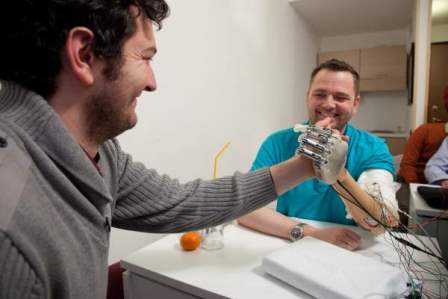Prosthetic hand controlled through nerves has the lightest touch
26 November 2014
A prosthetic hand which connects to the nervous system provides a sense of touch light enough to handle an egg. The hand has been developed by the EU-funded NEBIAS project after 10 years of research.
The researchers have created a new neural interface to link the patient’s nervous system and brain with the sensors embedded in the hand, enabling the user to control complex hand and finger movements.
The hand was tested with the help of amputee Dennis Aabo Sørensen who was able to grasp objects intuitively and identify what he was touching, while blindfolded.
Mr Sørensen, whose hand was amputated ten years ago and has been participating in the project’s experiments, said, "They gave me a baseball to hold and for the first time in a decade I could feel I was holding something round in my prosthetic hand."

Dennis Aabo Sørensen operates the prosthetic
hand
To make it possible for Mr Sørensen to feel the shape of the object he was holding, the researchers first had to develop a selective, implantable neuro-interface. "Selective means, for example, that when I’m talking to you in a crowd, I’m not talking to a guy sitting close to you. In other words, the electrodes have an interface with some areas of the nerves and not with others close by," explains project coordinator Dr Silvestro Micera.
Micera and his team enhanced the artificial hand with sensors
that detect information about touch, which is sent in real time to
the patient, allowing for the natural control of the hand.
With the prototype passing its initial tests with flying colours,
the next stage is to identify two or three people to test the
prosthesis over some years, with all the elements being portable,
wearable or implanted. If that works, in five or six years from now
the final stage would be a large-scale clinical trial to establish
if the prosthesis can be used widely. Dr Micera firmly believes the
prosthesis will be available in ten years time.
Innovation through collaboration
This multi-disciplinary research brought together researchers from materials, computer and neuro-sciences, biomedical microtechnology and electronic engineering. Over these different EU funded projects, scientists from 29 different institutions, involving 7 EU countries (and USA) worked together to make a prosthetic hand that can enable natural sensation and motion.
NEBIAS, also, was launched at the start of November 2013 and will run for four years. It receives EUR 3.4 million from the European Commission’s 7th Framework Programme .